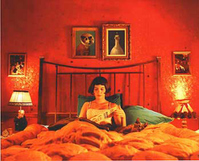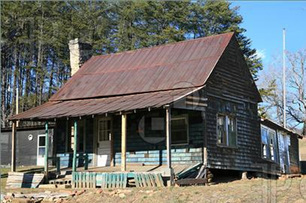I used to be infuriated by house beautiful magazines with their instructions on how to get “this season’s look” or directives to “sprinkle your home with soft and dainty designs in sweet candy hues” or apply wallpaper that "looks uncannily like real distressed timber planks". To me, magazine houses used to look more like empty stage sets than homes: where were the butter-smeared plates on the bench, the discarded socks in the bedroom, the specks of toothpaste on the bathroom mirror?
I particularly hated those narcissistic, self-satisfied home-owners who get "renowned architects” to “revitalise” their simple little multi-million dollar baches. Then everything changed ...

I had just finished an article about an interior decorator who had clever sawn a few books in half iso they would fit into an inconveniently shallow bookcase, when the phone rang. It was the editor of “The Recidivist Home” magazine asking to feature my home in their next issue.
Of course I was reluctant ... but when she promised to put the dog and I up in a motel during the photo-shoot I said yes. Well! The article (reproduced below) is fabulous darlings! I’m a complete convert to house beautiful magazines!

Although the flat is in a graceless, 1970s stucco block, Ro saw potential in its utter charmlessness. Walking up the pot-holed driveway to her urban hide-away, Ro points out the unpruned vine threatening to topple a neighbour’s fence and the clutter of early model cars and vans parked along it. “I love the informality of it all” she says, pointing out the remnants of a soggy Corona beer carton and a small pile of shingle which might one day be used to plug the holes in the drive. “We’re really close to all amenities” she adds, gesturing to the supermarket trolley parked handily just across the road.
Ro considers herself lucky to have found a place in this condition. “If this was an architect-designed eco-house nestled into a multi-layered site with breath-taking sea views it would have cost a fortune to add this raw authenticity - people employ armies of architects and landscapers to create this effect.” Quite unexpectedly, the place is also turning out to be a bit of a money-spinner. Ro points to the palings which are falling like decayed teeth from the stretch of fence outside her door. “Each time one falls off, my neighbour salvages it” she explains, “we’re selling them for big bucks to an interior designer up in Auckland”.
To keep the original feel of the place, Ro has kept the late mid-century New Zealand vernacular architecture intact: fly-screen door, windows sealed up by careless paint jobs, faux-tile lino, mismatched kitchen taps, and Pinex ceiling tiles. “It would be just plain wrong to tamper with these period details” says Ro, although she admits that the place isn’t in completely original condition: unfortunately the previous owner installed a heat pump and put insulation in the ceiling. Consequently Ro doesn’t use the traditional two-bar electric heater for winter warmth. However, Ro reports that there’s an upside to this ill-judged renovation. The machinery for the heat pump, bolted to concrete steps beside the front door, complements the bulky meter board and galvanised waterpipe handrail to create an industrial vibe which is “right on trend”. The front door boasts a pleasingly distressed look. “I didn’t even have to do that myself” says Ro gaily, as if she still can’t believe her luck. “The positioning of the heat pump and the handrail make it tricky to get furniture into the house, so the door has had a real bashing”.
Ro’s flat is tiny but it doesn’t feel cramped: she’s used strategically-placed mirrors to increase the sense of space, although Ro admits that it can be a bit disconcerting for first time visitors - “They don’t know if they’re coming or going”. Even Ro found living in such a small space challenging at first. “It took a while to figure out exactly how high I can stack the dirty dishes without them toppling over” she laughs.
Everything in the place is sourced from opp shops and the Nelson Recycle Centre or has been gifted by friends. The result is an eclectic mix of beat-up furniture, soft-furnishings and objets given visual coherence by a restrained colour scheme of white, pale green, rose-pink and turquoise. According to Ro, the palette “evolved organically” and depended very much on whatever paint the recycle centre happened to have. Ro’s slap-dash approach to painting is totally in keeping with her home’s casual ambience.
She’s taken the same loose approach in the garden. Before she moved in, the back yard was a wasteland of dandelion and paspalum. Now many other plants are flourishing, and not all of them are weeds. “I find anything that’s drought resistant and requires absolutely no maintenance does really well” says Ro. Asked to sum up what she most loves about her home Ro laughs yet again: “There aren’t any Joneses to keep up with!”
 RSS Feed
RSS Feed

